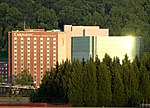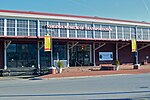Roanoke Warehouse Historic District
Buildings and structures in Roanoke, VirginiaHistoric districts on the National Register of Historic Places in VirginiaIndustrial buildings and structures on the National Register of Historic Places in VirginiaIndustrial buildings completed in 1902NRHP infobox with nocat ... and 4 more
National Register of Historic Places in Roanoke, VirginiaShenandoah Valley, Virginia Registered Historic Place stubsUse mdy dates from August 2023Warehouses on the National Register of Historic Places

Roanoke Warehouse Historic District, also known as 'Wholesale Row," is a national historic district located at Roanoke, Virginia. It encompasses five contributing buildings constructed between 1889 and 1902. All the buildings are constructed of brick, two-to-four stories in height and three-to-eleven bays in length. Two of the buildings have exceptional corbeled stepped gables in a Dutch-vernacular tradition. The buildings were erected for wholesale food storage.It was listed on the National Register of Historic Places in 1983.
Excerpt from the Wikipedia article Roanoke Warehouse Historic District (License: CC BY-SA 3.0, Authors, Images).Roanoke Warehouse Historic District
Norfolk Avenue Southwest, Roanoke
Geographical coordinates (GPS) Address Nearby Places Show on map
Geographical coordinates (GPS)
| Latitude | Longitude |
|---|---|
| N 37.273055555556 ° | E -79.943611111111 ° |
Address
Norfolk Avenue Southwest 127
24011 Roanoke
Virginia, United States
Open on Google Maps








